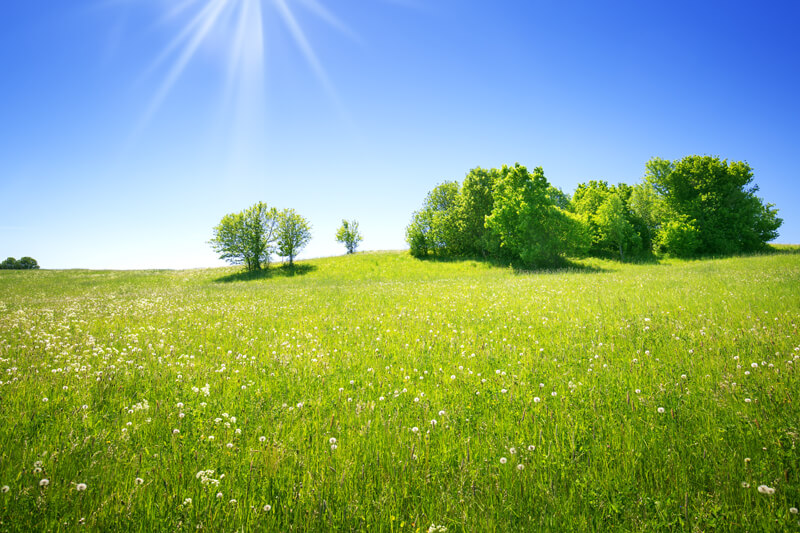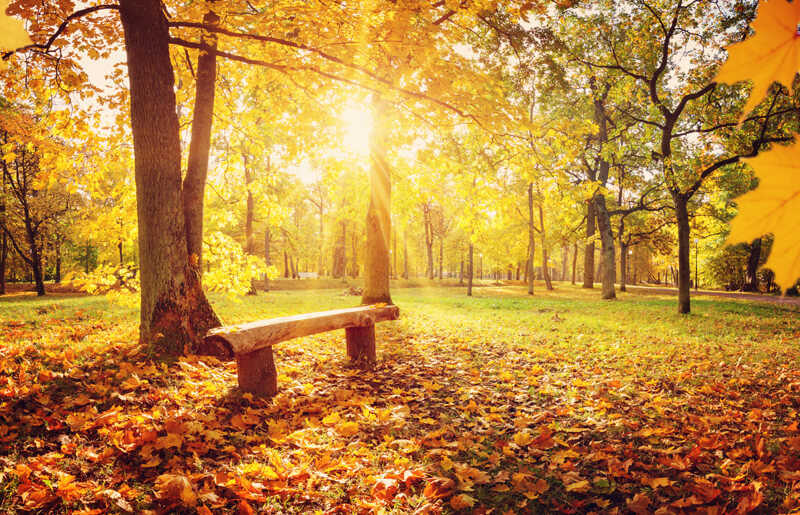
Throughout Delaware, property owners can enjoy all the splendors of the four seasons. Winter, spring, summer, and fall, in this part of the United States, we enjoy wonderful weather and exciting changes throughout the year. When it comes to enjoying the seasons, it’s smart to start at home. The lawn, trees, landscaping, and gardens surrounding your Delaware home or business provides one of the most enjoyable ways to enjoy every season. Whether you’re surrounded by lush lawns, turning leaves, or wintery scenes, your lawn and yard will reflect the seasons’ changes.
Of course, the way your property looks in each season is also a reflection of the care and maintenance you provide. Working to create a healthy lawn is nothing new. In fact, according to internationally-recognized turfgrass scientist, Dr. James B Beard, in an interview with The Lawn Institute,
“It is evident that for many, many hundreds of years, man has been willing to invest time and money in improving turfgrasses to achieve better functional, recreational, and aesthetic benefits. Why? Basically, turfgrasses were developed by modern civilizations in order to enhance the quality of life of humans. The more technically advanced a civilization, the more widely turfgrasses are used.”
Over time, people have learned ways to keep lawns, gardens, and yards looking their best in every season. The management of your lawn and garden, like most property maintenance tasks, continues in every season. It’s necessary to understand the proper care and practices appropriate for spring, summer, fall, and winter if you want to create a lawn that looks great throughout the year.
According to the Penn State Extension Service,
“To obtain optimum performance from your lawn it is important to employ the appropriate management practices at the correct times of year.”
We agree. That’s why, in this article, the experts from R&L Irrigation will share ways for homeowners and businesses to not only understand all the tasks that need to be completed in every season, but we’ll also offer practical tips to keep your lawn and landscaping looking great all year long. Take a look at our seasonal checklists to make sure you’re preparing your lawn and maintaining your property in ways that make it look its best in every month of the year.
The Year-Round Lawn Care Checklist
Experts agree. By caring for your lawn, garden, and landscape properly in every season, you not only make it look good right now, but you also prepare your turf for the coming seasons. Year-round care ensures your grass, flowers, trees, and shrubs will remain healthy and vibrant in every season. According to Dr. Leonard Perry, Horticulture Professor Emeritus at the University of Vermont,
“Proper lawn care including mowing, fertilizer, and watering, will help it survive winter in good health. It will be able to resist diseases and weeds better next season, and to start off next year in good shape.”
While we will dig into seasonal tips for your property, there are some basic lawn care tips that property owners should follow 365 days a year. Before we give checklists for every season, we also wanted to share this checklist to use anytime you mow or care for your lawn.
Overall Lawn Care Checklist
- When to Mow and When to Skip Mowing your Lawn
Some homeowners mow on a schedule. However, your lawn grows at different rates depending on the type of grass, sunlight, temperature, rainfall, soil quality, available nutrients, and even air quality. With so many factors at play, it’s smart to limit lawn-mowing to an as-needed basis, instead of scheduled mowing. In fact, no matter which season you’re in, mowing your grass too short or too often can damage your lawn. Over-mowing can harm the foundation of the turf and decrease the lifespan of your grass. Greens cut at higher settings are able to grow deeper roots, which allows them to get more nutrients from the soil and weather droughts. - Use the “One-Third” Mowing Rule
When grass gets overgrown, it’s tempting to cut it down all at once. However, it’s important to avoid cutting your turf more than a third of its height in any one mowing session. For example, if you find your grass has grown to six inches while you were on vacation, don’t mow off more than a third in one day. Instead, mow it down to 4 inches. Wait a few days and then mow it down to two or three inches. If you mow off more than a third of the height in one mowing session, you risk stressing the lawn, which can eventually result in dead grass. - Mow Frequently While the Grass is Growing
When your turf is growing, try to mow your lawn two to four times a month. In addition to preventing situations in which you need to mow more than one-third of the blades, frequent mowing reduces the build-up of thatch, that layer of stems and roots between the green vegetation and the earth. Less thatch means less dullness, which results in a lawn that looks bright green and shiny. Don’t mow when your grass is not growing, during winter months or severe droughts, or you may shock your lawn, killing some or all of your turf. - Alternate Your Mowing Pattern
Reduce soil compaction by alternating your mowing pattern. When you mow in the same direction over and over again, the grass gets flattened or compressed. Compaction can block rainwater. Alternating your mowing patterns also reduces changes of root damage from surface stress. - Don’t Remove Short Grass Clippings
Leaving short grass clippings on your turf after you mow can provide a nutrient-rich fertilizer. After all, grass clippings are mostly water, so they break down quickly without becoming thatch. However, if your lawn clippings are longer than usual, you may want to remove them. - Give Your Turf the Right Amount of Water
Underwatering and overwatering are two of the most common ways to damage or even kill a healthy lawn. While most homeowners and businesses in Delaware understand the dangers of underwatering, overwatering presents almost as many hazards. When your yard gets too much water, especially in humid conditions, overwatering may encourage the growth of fungi, including rust fungi, mushrooms, and anthracnose, which turns grass into an unattractive brown color.
How do you know if you’re overwatering? These lawns feel soft and spongy. The soil may look wet, or you may see puddles. Runoff into your driveway or the street is also a sign of overwatering.
The Spring Lawn Checklist
Spring is the time to get things going and growing on your property. Give your gardening tools a spring cleaning and make sure they’re working. Prepare your lawn in ways that allow it to thrive all through the growing season. Prep beds and guard against pests. Here’s our checklist to help you get started.

- Get Your Lawn Mower Ready
Spring is the time to sharpen mower blades to ensure they are able to make clean cuts that prevent jagged, brown edges on grass blades. Most experts recommend sharpening mower blades about once a month during mowing season.
Get your mower new spark plugs and filters and buy fresh gas. Fuel leftover from last fall may have accumulated moisture, which can harm your mower’s engine. If you must dispose of leftover gasoline, make sure you follow local ordinances for the disposal of hazardous fuels.
Wipe down the top and remove dirt and grass clippings from the undercarriage. To be safe, detach the spark plug wire servicing, and don’t flip a gas mower over. Instead, lift one side when working on the undercarriage.
Finally, after months in storage, a lawnmower may not start quickly when you’re ready to mow in the spring. That’s why it’s a good idea to place it in the sun for a few hours before starting it up for the first mow of the season. Time in the sun literally “warms up” the machine and makes it easier to start. To increase the sun’s warmth, cover the engine with a dark garbage bag for a few hours, and remove it before you start the mower. - Clean up Yard Debris
Over the winter months, your property probably accumulated a fair number of twigs, pinecones, leaves, and debris. Before you start gardening or mowing, use a rake or shovel to gather up organic waste and give your glass and plantings sunlight and air. Removing debris is also an excellent first step if you plan to apply fertilizers or herbicides. - Aerate Your Lawn
Over the course of a year or two, grass and soil become compacted from foot traffic and mowing. This creates a layer of dead and decomposing grass between growing soil called thatch, which can slow or hinder lawn growth. Using a garden aerator allows you to create tiny holes throughout the lawn that loosens the ground and makes it easier for oxygen, water, and nutrients to reach the roots, stimulating growth.
For best results, aerate damp but not soaked soil. For larger aeration projects, consider using a professional lawn care service. - Fertilize Appropriately
When it comes to fertilizing your lawn, each property is different. Your lawn nutrient needs can vary based on your soil type, the property grade, the surrounding landscaping, sunlight, wind, and more. Some lawns will need fertilization throughout the year. In other cases, overfertilization may actually damage turf.
According to the Virginia Department of Conservation and Recreation,“Not only is over-fertilizing a waste of time and money, it can do serious harm to the plants you intend to help. Fertilizers are salts, much like table salt. If tender plant roots are close to fertilizer granules, water is drawn away from these roots and they dehydrate. Over-fertilizing trees or shrubs, particularly with slow release fertilizer, can also cause them to keep growing into the fall when they should be hardening off for winter.”
If you’re unsure whether to fertilize, consult a lawn pro. Even if fertilization is right for your property, wait until the grass starts growing before applying the nutrients. Most types of turf roots store carbohydrates through the winter and release them in the spring to boost early growth. Because of this, any additional fertilizer is most useful if it is applied after the grass has exhausted its natural reserves.
- Edge Beds and Mulch
Some types of grass spread by producing more leaf blades off to the side of the main plant (tillers.) Other types of grass spread with underground runners (rhizomes) or above-ground runners (stolons). Edging is an effective way to keep grass and invasive weeds out of your beds.
For many property owners, early spring conditions offer the kind of soft soil that makes edging beds reasonably easy. Whether you prefer to use a spade, a shovel, or even a hoe, cutting a two or three-inch deep, V-shaped trench will keep many types of lawn grass and weeds from entering your beds.
Once the sun has warmed up your beds, it’s time to apply mulch. While many homeowners like the polished look of mulch, it’s also a practical way to prevent weeds from growing. Just two or three inches of mulch around existing plants will keep weeds at bay. Many homeowners create small beds of mulch, with edging, at the bases of trees. This also gives a neat appearance and reduces mowing and trimming time. - Overseed Your Turf
Most Delaware lawns will look a little worse for wear after a cold, wet winter. Spring is a great time to thicken a thin lawn with overseeding. Timing and techniques will vary based on your lawn, the type of grass on the property, the grade of your property, and the health of your current yard. This is a great time to call in an expert to talk about your lawn’s needs. And if you choose to overseed your lawn, remember that you must lightly water newly-seeded areas daily for two or three weeks to ensure seeding takes hold. - Create a Weed Control Strategy
For some shady lawns, violets are a problem. Sunny properties attract dandelions. While many property owners are familiar with crabgrass and clover, many other types of weeds are common on Delaware lawns, including chickweed, dead nettle, speedwell, shepherd’s purse, carpetweed, knotweed, mallow, and purslane. Some of these weeds can be controlled with standard lawn herbicides, while others may need special treatments. Additionally, if children or pets are using your lawns, you’ll need to take special precautions to protect their health and safety. - Look out for Grubs and Other Pests
Hibernating grubs appear in the spring, ready to consume your turf’s roots before turning into beetles. It’s smart to treat your entire lawn for if you had a grub infestation in the previous season, or if your neighbors see grubs. Snails, slugs, beetles, and aphids can also be a problem that require insecticides. Again, take special precautions before applying any insecticides to protect the safety of children or pets.
Moles, voles, groundhogs, and even rabbits can quickly destroy a carefully manicured lawn. If any of these animals are a problem, it’s wise to consult a professional pest control service to find the strategy that protects your lawn and garden.
However, when devising a pest control plan, make sure you’re not also killing productive organisms, also called beneficials, such as earthworms, bees, and ladybugs. Many homeowners also want to attract butterflies to their yards.
Birds and bats are natural ways to control insect and pest populations, so consider adding birdhouses, bat houses, and water features that attract birds, like birdbaths or fountains, to your landscape. - Inspect Your Irrigation System
If you have an automatic watering system, get the system inspected to ensure it is intact after the long, cold winter. Remember to adjust your timers as weather changes, and check for damaged or leaking heads, especially after the system is used for the first time in the season.
The Summer Lawn Care Checklist
Once summer has arrived, it’s time to let your landscape shine. Your biggest job will be to keep up with lawn mowing and plant growth. Make sure you’re watering and fertilizing correctly, and as always, keep an eye out for weeds and pests.

- Keep up With Mowing
Once summer arrives, lawns come alive and grow vigorously. The mild Delaware climate combined with plenty of rainfall means that greens in our state grow quickly. When the weather gets hot, it’s time to increase the height of your mower. When you keep your lawn height at three inches or more, grass can develop deeper root systems. Deeper root systems make lawns more hardy during droughts, able to resist diseases better, and more efficient at obtaining the nutrients they need from the surrounding soil.
Less frequent mowing also slows down your grass’s natural growth rate. During the hot months of summer, try to reduce mowing to once a week or less. As we mentioned in our year-round lawn checklist, used the one-third rule, and avoid cutting more than one-third of the grass height in any two days. And remember, sharp mower blades will ensure you’re cutting, not tearing, the grass. - Keep Your Lawn Watered, but Don’t Overdo it!
While some people think more water is better, overwatering a lawn in summer can cause catastrophic damage, including wide-spread mildew, which can kill your grass. To prevent overwatering and underwatering, consider smart irrigation systems developed for Delaware climates. They use a sensor to measure moisture, which means they water areas when needed, and hold off when seasonal rains do the job. Another benefit of automatic watering systems is that they can work on timers, watering your lawn during the very early morning hours, when it’s most effective. - Continue Watching for Weeds and Turf Pests
Even if you dealt with weeds and pests in the spring, they could return. And if you didn’t get a chance to deal with critters and unwanted, invasive plants in the spring, this is the time to do it.
If your lawn has a few weeds, it may be easy to bend down and pluck them when your garden is damp, and plants are easy to pull.
Chemical solutions may be more effective for large yards or if your turf is overrun with weeds. To avoid stressing your grass any further, apply herbicides when temperatures will remain below 85° F. And consider how herbicides will affect pets and children. If you’re unsure of the safety of your herbicide, consult the professionals.
Summer also ushers in the arrival of some especially harmful critters such as sod webworms, grubs, beetles, carpenter ants, fleas, chinch bugs, aphids, and even mosquitos. Uncontrolled insect populations can get out of hand quickly. Your lawn’s symptoms of infestations include wilting, dead grass patches, scorched-looking grass when the weather is not dry, pockmarked blades, and other signs of feeding activity. If the pest infestation is extreme, lawn care profesionals can help you eradicate it. - Keep an Eye Out for Summer Fungal Diseases
In the summer, six lawn diseases are common. These include Dollar Spot, Necrotic Ring Spot, Summer Patch, Fairy Rings, Powdery Mildew, Red Thread, and Rust. In the wet, mild climate of Delaware, these types of summer fungal disease are a problem. Avoid watering in the evenings and overwatering in general, since these are the primary causes of fungal diseases. During a wet summer, these diseases may appear without any additional lawn watering. For small patches, you may be able to control the condition with a fungicide, as advised by an expert. For best results, more significant problems should be tackled by a lawn care service. - Check Your Irrigation System
If you have installed an automatic watering system, make sure the irrigation system is working correctly. Your irrigation system supplier can give you maintenance tips that ensure the system is able to deliver the appropriate amount of water to each part of your lawn. - Boost Your Fertilizer
After your lawn greens up in spring, it’s time to develop a schedule for timely applications of lawn fertilizer throughout the summer. Regular boosts of fertilizer will keep your lawn strong, healthy, and green all summer long. If you hire a lawn care service, they will develop a lawn care service schedule for you, and make sure their fertilizer choices are safe for pets and children.
Your Fall/Autumn Lawn Checklist
Once the summer heat breaks, it’s great to spend time outside during chilly evenings and enjoy the beauty of fall in Delaware. While the weather is still warm enough, it’s essential to keep on top of autumn leaf removal. This is also the time to start preparing for winter by prepping your lawn, doing a little cleanup, and giving your tools one last clean up before storing them away. Here’s a checklist to help you keep on top of autumn lawn care chores.

- Rake Those Leaves!
Once fall arrives, your primary job shifts from mowing to raking. If your yard is large or you’re dealing with leaves from large trees, you may want to call in the experts. No matter if you call in a team or do it yourself, if you want a healthy lawn, you must keep your garden relatively free of leaves, twigs, pinecones, and other natural debris. If you’re lucky enough to own a mulching mower, use it to chop up leaves, and add the organic matter to your soil. After you’re done, look over your lawn to pick up clumps so they don’t kill the grass. - Should you Fertilize?
If you have kept on top of fertilizer in spring and summer, you may be able to skip it in the fall. However, if your lawn was stressed this season by bugs, fungi, weeds, or drought, it may be time to give it another fertilizing treatment. When in doubt, consult your lawn care professionals. - Change Your Mowing Habits
In Delaware, lawns usually keep going strong well into October. As long as your grass keeps getting taller, you must continue to mow your lawn. However, as the turf growth slows down, lower the mowing height from the summer height of three-four inches to just two inches.
Even during the last mows of the season, follow the one-third rule: don’t trim more than one-third of the grass blade in one session. It’s better to gradually lower the cutting height until the final two cuttings.
Mowing at this lower height for the last few cuttings of the season enables more sunlight to reach the crown of the grass, which means less of the blade turns brown during the winter. - Aerate the Lawn
If you didn’t get to do it in the spring, autumn is also an appropriate time to aerate. Homeowners with smaller lots may want to tackle this as a DIY project. But if you’ve got a large property, it can be an overwhelming task. It may make sense to hire a landscaping contractor. - Patch Your Lawn’s Bald Spots
When the weather gets colder, it’s time to tackle your yard’s bare spots. Small patches can be handled with a lawn repair kit that bundles grass seed, quick-starter lawn fertilizer, and mulch.
Use a rake or hoe to work the topsoil in the affected area lightly. Then cover it with a thick layer of the lawn repair mixture and gently tamp down the mix. Water thoroughly and keep it lightly moist for the next two weeks.
As with most lawn projects, this is an easy one if the area is small. If you have a turf pockmarked with a series of bald spots, you may need a more comprehensive solution. Call your local lawn care professional for an evaluation. - Overseed, Again
Yes, even if you overseeded in the spring, you should repeat in the fall. However, this time you must complete your overseeding in early fall before the weather gets too cold. Give your seeds time to germinate and take hold before winter arrives.
This is also an excellent time to introduce more resilient grasses in your overseed. During the process, hardier varieties that are well-suited to the Delaware climate can be added.
As the grass thins out, make sure that the seeds you use make contact with the soil. If you’ve aerated, overseeding immediately afterward may help seeds take hold. Once the seeds are down, keep them lightly watered until they germinate. - Watch for Autumn Weeds
Even if you treated your lawn for weeds in the spring or summer, you might find they bounce back in the fall. Applying herbicides to these weeds before the temperatures dips prevents them from dropping seeds that will re-emerge in the spring. As always, consider pets and kids whenever dealing with herbicides. - Prep Your Lawn Care Tools and Mower for Winter
While it’s smart to care for your lawn care tools all year round, they need special attention in the fall. Clean all your hand tools such as spades, and long-handled tools, such as shovels. Wipe off any dirt or debris. Use a soft cloth and a bit linseed oil to lightly coat any metal parts to protect them from rust. If the tools have a spring (such as a clipper), you may want to use WD-40 to coat moving parts and keep them protected in the cold weather.
If you use garden gloves or hats, give them a gentle washing before putting them away for winter.
Empty the gas from your mower, and make sure the blades are clean and dry. This is a great time to sharpen the blade and coat it with a thin layer of oil to keep it from rusting over the winter. Store your mower in a covered building to protect it from rain and snow. Keep it away from chemicals, cleaners, or anything that might cause corrosion if spilled. - Store Chemical and Fertilizers Safely
Many homeowners will have chemicals and fertilizers left over at the end of the season. When storing these sensitive substances, there are some safety practices to follow. If you’re dealing with plastic bottles, they will not be affected by temperatures and can be stored in cold places, such as an unheated shed. However, changes in humidity and temperatures can cause metal containers to rust and can make cardboard get damp and fall apart.
As you think about places to store these substances, read labels, and follow the manufacturers’ instructions. Generally, if you can keep it from freezing, in a dark, dry place, such as a basement, it will stay intact over the winter. When storing these items in your home, be sure they are out of reach of children and pets. For example, a locked cabinet may be safer than stowing them on a high shelf.
If you don’t have a dark storage space, try storing items in a garbage can with a tight-fitting lid. Some homes use totes with handles they can lock (to keep away from children and animals.)
However, read labels and don’t store anything in a closed container that may be combustible. Oil, gas, and fuel should not be stored in the home. Many of these substances will not remain stable over the winter and should be disposed of in an appropriate recycling or waste facility. - Plan Next Season
It’s easy to make plans curled up by a fire. During the winter, it’s almost fun to think about green lawns and gorgeous flower beds. If you haven’t evaluated your lawn soil yet, you can do it during the winter months.
Dr. Perry from the University of Vermont advises,“If you haven’t tested your soil before, or in a few years, now is a good time. The results will tell you if any other fertility or lime is needed. As many soils become more acidic over time, lime is often needed to keep the soil acidity or pH between 6.0 and 7.0. Add lime in the fall as it is slow-acting, and its effect won’t be fully realized until spring. Soil test kits are available from many full-service garden stores and your local university Extension offices.”
As long as the soil isn’t frozen hard, you can take and evaluate soil samples in the winter months. Take several soils samples from different parts of your property, since the pH will vary from area to area. Once you get your soil tested, it’s easier to determine which types of turfs and plants will do best in different parts of the year. Soil pH results can also help you determine the best ways to amend or correct the earth to be better suited to existing plantings.
If you’re not up for this kind of science project, contact a lawn care professional to evaluate your soil and make recommendations based on the findings. - Care for Trees and Shrubs
It’s true! You must continue to care for your trees and shrubs during the winter. Start your winterization in the summer by stopping pruning after midsummer. Pruning stimulates tender, new growth, and delays dormancy. It’s also wise to stop fertilizing plants at least six weeks before the first frost for the same reasons.
When it comes to trees, mature specimens will be able to live through the winter without extra care. However, if you have young trees and shrubs you’ll need to take extra steps to keep them safe during cold weather. Apply a four-inch layer of mulch at the base of young trees and shrubs after the first frost. This insulates the soil, so it stays frozen longer and prevents heaving. Make sure you keep the mulch a few inches away from the trunk to avoid rot.
Protect young bark from gnawing pests with tree guards made of plastic or wire. Paint the south side of the trunk with diluted white interior latex paint to prevent sunscald and frost cracks. Alternately, wrap the trunk with paper tree wrap.
Protect conifers and evergreens from breaking by gently removing snow after storms. However, if your branches are covered with ice, leave them alone. Trying to remove ice can cause as much harm as good.
If your evergreens get road salt sprayed on them by passing cars or snowplows, protect them with burlap or shrub wraps. Note that white pines are especially susceptible to damage from road salt. If this is a recurring problem, consider replanting them in spring, further away from roads, or replacing them with less sensitive evergreens.
If deer are eating your hedges and shrubs during the winter, burlap or shrub wraps will protect your trees and hedges. - Remove Debris, Toys, and Furniture
When grass is dormant, it is more susceptible to damage. That’s why it’s important to keep branches, dense piles of leaves, debris, toys and sleds, lawn furniture, or even dead plant leaves off the grass during winter months. Avoid walking or playing on dead grass. Once the grass is compacted or smothered, conditions improve for harmful pests and diseases that can quickly spread throughout your lawn. Happily, light leaf falls are not dangerous, so don’t panic if a few leaves remain on the lawn after the last fall leaf-raking party.
Your Winter Lawn Care Checklist
Delaware winters can be extreme. When the winter winds blow, there is very little you can do to prevent turf from browning or even dying in extremely harsh conditions. However, this doesn’t mean you don’t have to think about your yard during the winter months. While your turf and landscaping won’t take much time during this time of year, there are still a few items on your winter lawn care checklist.
Should You DIY or Hire a Pro?
As this article illustrates, there are many simple lawn care tips you can complete all year long without the help of a lawn professional. And property owners with small lawns may not need or want the help of a professional team. However, purchasing and maintaining lawn care tools like riding mowers, aerators, fertilizer spreaders, and leaf mulchers can be expensive and time-consuming, especially if you have a large yard to maintain. If you want a spectacular lawn that looks its best in all seasons, a professional lawn care service may be the way to go. If you’re in Sussex County DE area, call R&L Irrigation today and find out what we can do for your lawn.





